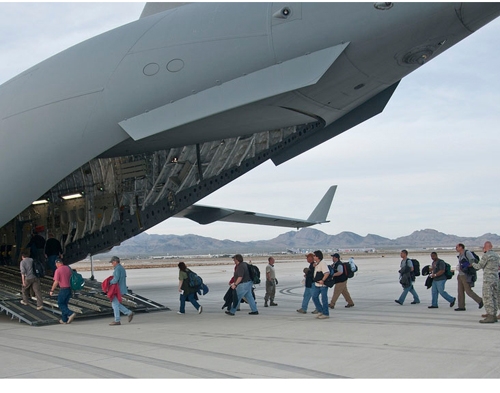Nevada-based nuclear response team arrives in Japan
A team of experts on tracking radioactive contamination, which deployed from Nellis Air Force Base, has arrived in Japan to help authorities assess radioactive gases spewing from nuclear power reactors that overheated and exploded after the devastating earthquake and tsunami, a National Nuclear Security Administration official said Wednesday.
"The government of Japan and the U.S. Embassy have both asked for our assistance," said Damien LaVera, NNSA's director of public affairs.
He said the 33-member team boarded a C-17 Globemaster cargo plane at the Nellis base and left with 17,200 pounds of equipment late Monday afternoon, arriving in Japan at 4 p.m. Pacific time Tuesday (8 a.m. Wednesday in Japan).
LaVera said some team members are from the agency's Nevada National Security Site office in North Las Vegas. The NNSA is a semi-autonomous agency within the Department of Energy.
The 33 team members joined six other DOE personnel who were already in Japan.
The Department of Energy sent two experts to Japan to provide advice and technical assistance. One is an expert in emergency response, who is part of the U.S. Agency for International Development Disaster Assistance Response Team. The other is a nuclear engineer with Japanese language skills, LaVera wrote in an e-mail Wednesday.
"We are positioning consequence management response teams at U.S. consulates and military installations in Japan," he said. "These teams have the skills, expertise and equipment to help assess, survey, monitor and sample areas."
The response teams include "folks who can take readings on the ground," LaVera said in a phone call from Washington, D.C.
The equipment for the Aerial Measuring System capability, includes detectors and analytical devices to provide assessments of ground contamination.
The Department of Energy also is monitoring the response teams through its Nuclear Incident Team "and is employing assets at its national laboratories to provide ongoing predictive atmospheric modeling capabilities based on a variety of scenarios," LaVera said.
He said the response entities are different from the Nuclear Emergency Search Team, which also has personnel and assets in Nevada.
DOE officials said the 39 team members include four staff members at the U.S. Embassy in Tokyo and two federal team leaders to support the Consequence Management Response teams and the Aerial Measuring System teams.
Japanese authorities ordered emergency workers to withdraw from its stricken nuclear power complex Wednesday after a surge in radiation.
DOE and the U.S. Nuclear Regulatory Commission both have experts at the complex of six reactors along Japan's northeastern coast, which was ravaged by last week's magnitude-9 earthquake and subsequent tsunami.
Crews from the Tokyo Electric Power Co. scrambled to install a new power line to the crippled Fukushima Dai-ichi plant to revive water pumps for supplying cooling water to reactors and spent fuel ponds.
There are six reactors at the plant. Units 1, 2 and 3, which were operating last week, shut down automatically when the quake hit. Since then, all three have been rocked by explosions. Compounding the problems, on Tuesday a fire broke out in Unit 4's fuel storage pond, an area where used nuclear fuel is kept cool, causing radioactivity to be released into the atmosphere.
NRC Chairman Gregory Jaczko said all the water was gone from the spent fuel pools at Unit 4 but Japanese officials denied it.
If Jaczko is correct, it would mean there's nothing to stop the fuel rods from getting hotter and ultimately melting down. The outer shells of the rods could also ignite with enough force to propel the radioactive material over a wide area.
The Associated Press contributed to this report. Contact reporter Keith Rogers at krogers@reviewjournal.com or 702-383-0308.

















